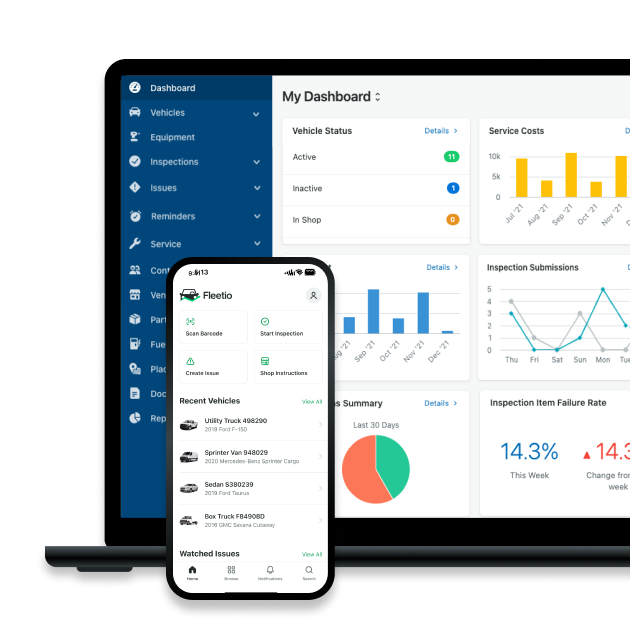Tips for Allowing Employees to Charge EVs at Home
With charging infrastructure still leaving much to be desired in the US, fleets should be open to more creative means of replenishing electric vehicles.
Feb 21, 2024
6 min read

As an employee perk, many fleets allow their drivers to use company vehicles for personal activities (like commuting or running errands). When administered with sensible rules, such programs result in a win-win situation for all involved. Drivers benefit from less wear and tear on their personal vehicles, while fleets enjoy higher employee retention rates thanks to having more satisfied personnel.
With fleets adopting electric vehicles (EVs) in larger numbers each year, now is the perfect time to consider the upsides and challenges of drivers taking EVs home.
The Advantage of Charging EVs at Home
Despite valiant efforts from private companies and all levels of government, EV infrastructure in the US is highly hit-or-miss. According to the latest data from the US Department of Energy’s Alternative Fuels Data Center, over 25% of all public charging stations in the country are located in California. With more than 15,000 places to plug in, California stands in stark contrast to Alaska, South Dakota, North Dakota and Wyoming, all of which have less than 100 public EV chargers respectively. This uneven distribution makes charging fleet vehicles via public stations a nonstarter for most organizations (especially when the relatively limited range of EVs is one of the most common concerns among EV skeptics).
Did you know?
There may be hope on the horizon for America’s EV infrastructure. In 2021, Congress passed a bill that allocated $7.5 billion to building 500,000 additional public EV charging stations by 2030.
But on-premise EV charging isn’t without its challenges either. To replenish an ample number of EVs at Level 2 or 3 charging speeds, most fleets will need to upgrade their facilities, a process which can be both expensive and time-consuming. In fact, some Fleetio customers have told us that their utility companies have multiple year-long lead times for electrical system upgrades.
While fleets wait for America’s infrastructure and their own facilities to catch up with the needs of EVs, at-home charging provides a convenient workaround. By having drivers plug in their EVs when they get home from work, fleets can ensure their vehicles are ready to go the next morning while providing a meaningful perk to their employees.
Track your EV charging expenses
At Home Charging Hardware
Basic: Level 1 Charging
While a typical 120-volt household outlet can charge an EV, Level 1 charging speeds aren’t sufficient for most fleet vehicles. Even left overnight, a standard outlet can only provide about 40 miles of driving range. That might cover a driver’s commute, but is unlikely to enable a full day of work.
Advanced: Level 2 Charging
Level 2 charging is what most fleets will require to effectively replenish their EVs from home. Less than two hours of being plugged into a Level 2 charger will get you 40 miles of driving range. Left overnight, you can fully recharge the battery of just about any EV.
While Level 2 charging is possible in some cases with a preexisting 208V-240V outlet (like what your dryer is likely plugged into), most homes will need some amount of upgrades in order to adequately charge a fleet vehicle. For starters, if your EV didn’t include one with purchase, you’ll need to buy a Level 2 charging unit. While prices vary based on brand and feature set, $350 is a fair estimate for what that charger will cost you.
To create a compatible and accessible outlet for that charger, most fleets will need to hire an electrician. There are a myriad of factors that will determine the price of adding a new 240V outlet to a home, but expect to pay at least a few hundred dollars.
All this is to say that at home EV charging suits some homes much more than others. To avoid the impression that only favored drivers are allowed to take their EVs home, fleets should consider formalizing how much they’re willing to invest in upgrading a driver’s home to support Level 2 EV charging. By defining that amount and what conditions are required for a driver to qualify for taking a fleet EV home (e.g. length of employment, performance metrics, etc.), fleets can streamline their future decisions related to at home charging.
How to Reimburse Employees for Home Charging
Of course, even the fun and convenience of being able to take home an EV everyday can’t make up for the expenses associated with at-home charging. To keep their drivers in good spirits (and to comply with some state labor codes), fleets should always reimburse their employees for all EV-related electricity costs they incur.
There are three methods fleets can use to reimburse their drivers for at-home work vehicle charging:
1. Flat fee allowance
Fans of simplicity can opt to compensate their employees with a set amount every pay period. While this approach doesn’t require any calculations or data collection, as a result, it’s the most imprecise of the reimbursement methods. Underpayment can lead to driver resentment and even expose fleets to legal liability. Overpayment can hurt an organization’s bottom line.
2. Mileage-based reimbursement
Every year, the Internal Revenue Service (IRS) announces a new standard mileage reimbursement rate for vehicles driven for business purposes. By tracking their EVs’ odometer readings, fleets can use this reimbursement rate to calculate what they owe their drivers. While more accurate than the flat fee approach, this method hinges on a rate the IRS applies to both internal combustion engine (ICE) vehicles and EVs. And because ICE vehicles have significantly higher maintenance expenses than EVs, this method can also result in fleets overpaying.
3. “Real cost” reimbursement
Instead of using a ballpark sum or a generalized rate, the “real cost” method is based on how much electricity is actually used to recharge your EVs. Wattage amounts are captured from specialized meters installed in the driver’s home or via vehicle telematics. The wattage total is multiplied by the driver’s actual utility rate to determine the final amount owed to them. While the most involved of the methods listed here, real cost reimbursement is also the most accurate.
How Software Can Help EV Management
When it comes to tracking expenses, EV fleet management can be quite a bit trickier than keeping tabs on ICE vehicles. Without an equivalent to fuel cards to rely on, fleets often need to jump between telematics portals and their utility company’s website to know how much of their (or their employees’) electricity bill(s) went to EV recharging each month.
Fortunately, Fleetio’s EV fleet software makes knowing how much you’re spending on charging a lot easier. By clicking on an EV’s profile, you can instantly pull up a detailed charging cost breakdown based on that vehicle’s charging entries. This instant and anytime access to charging information makes tracking total cost of ownership a breeze and even allows you to compare the operating costs of your EVs against your other assets. Such comparisons help fleets make smarter procurement decisions that improve their bottom line.
Manage all of your fleet assets
Whether you’re all in on EVs or have a mixed fleet, you can track all of your operating costs from a single platform with Fleetio. Customizable reports and dashboards uncover insights that enable you to rein in your expenses.
Book a demoFrom our fleet community


Fleet Content Specialist
Through interviews, blog posts and webinars, Alex covers the tactics and technologies exceptional fleet managers use to achieve results. By sharing their success stories, his work aims to inform and inspire fleet professionals of all stripes.
LinkedIn|View articles by Alex BorgReady to get started?
Join thousands of satisfied customers using Fleetio
Questions? Call us at 1-800-975-5304
Get Our Newsletter
Join a community of 70,000+ fleet industry professionals.

